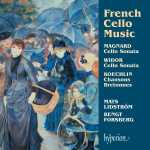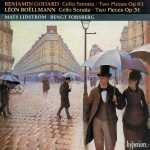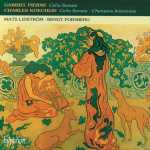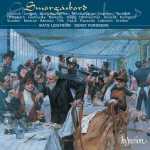
Composer: Charles Camille Saint-Saëns
Performer: Mats Lidström, Bengt Forsberg
Format: FLAC (tracks)
Label: Hyperion
Catalogue: CDH55342
Release: 1999
Size: 234 MB
Recovery: +3%
Scan: yes
Cello Sonata No. 1 in C minor Op. 32
01. I. Allegro
02. II. Andante tranquillo sostenuto
03. III. Allegro moderato
Le carnaval des animaux
04. XIII. Le cygne
Cello Sonata No. 2 in F major Op. 123
05. I. Maestoso, largamente
06. IIa. Scherzo con variazioni. Allegro animato
07. IIb. Variation 1. Poco meno allegro
08. IIc. Variation 2
09. IId. Variation 3. Tranquille, sans lenteur
10. IIe. Variation 4. Molto allegro
11. IIf. Variation 5. Sempre allegro
12. IIg. Variation 6. Molto moderato e marcato
13. IIh. Variation 7. Poco allegretto, tranquillo
14. IIi. Variation 8. Presto
15. III. Romanza: Poco adagio
16. IV. Allegro non troppo, grazioso
Le carnaval des animaux
17. XIII. Le cygne
The two sonatas for cello and piano by Camille Saint-Saëns stand as bookends to what was an impressively long compositional career spanning more than seven decades. Much of Saint-Saëns’ music for cello, including these two sonatas, has been dismissed as inferior and is rarely performed or recorded. Only the first cello concerto, often played by advanced students of the instrument, remains a common occurrence on disc or stage. While the assertion of cellist Mats Lidström that Saint-Saëns’ music is on a par with or even superior to other repertoire of the period is likely a dramatic overstatement, it certainly is worthy of attention and enjoyment. Joined by pianist Bengt Forsberg on this Helios album, Lidström engages in a passionate, animated reading of the two sonatas. Lidström plays with an immense amount of gusto and enthusiasm, downplaying any notion that French music needs to be treated as a delicate, fragile thing; however, he occasionally crosses the line with a right arm that is sometimes harsh, abrasive, and overly vertical. At key moments in the music, this sort of forceful, in-the-string playing can really capture a listener’s attention, but when used continuously it becomes tiresome. Despite Saint-Saëns’ recommendations to the contrary, the Romance from the F major Sonata is sentimental, almost saccharine at times. Still, there is a dearth of quality recordings of these works, and from a technical standpoint Lidström truly delivers even if his musical vision may seem over the top to some listeners.
Saint-Saëns today has become one of those composers known through only a handful of works, but his output was prodigious and there is a great deal of music waiting to be discovered beyond Carnival of the Animals. Unfortunately his long life led to him passing from fame as one of the most naturally gifted musicians ever, to someone who had become passé with the arrival of the likes of Debussy and Ravel. This probably explains the neglect of so much supremely crafted music.
As a classicist Saint-Saëns was attracted to sonata form throughout his life and the two cello sonatas illustrate well the consistency of his compositional style over the 33 years that separate them, there is always a French clarity about the writing and also an irresistible forward momentum which comes from a directness in the structural plan which harks back to Mozart and Beethoven.
By way of encores the disc offers two versions of the famous ‘Swan’ from Carnival of the Animals. The first was published by the composer before he allowed the release of the rest of Carnival (only published after his death), the second is an arrangement by pianist and Saint-Saëns pupil Godowsky for violin and piano, which has here been further transcribed for cello and piano.



